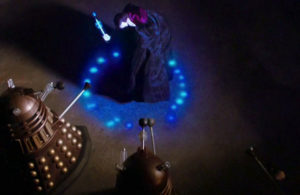Sciencey Wiencey: The Time of the Doctor
Guest contributor Caleb Howells investigates more Who science, this time from Smith’s swansong
This episode had some interesting sciencey ideas in it. Teleports and holograms are pretty standard, but holographic clothes isn’t something I’ve ever come across before. It’s an interesting concept, and the Doctor uses some clever-sounding language to explain it. But does it actually make sense?
Holographic Clothes

According to the Doctor, the image of the clothes is transmitted directly to the person’s visual cortex. This is basically the same thing that I talked about in the previous
However, being able to transmit the image isn’t the only issue. The TARDIS must also track the Doctor’s body to know where to place the image. Obviously, as the image is from Clara’s perspective, it could essentially use her eyes as a camera to track the Doctor. It would need to receive signals from her brain, as well as send them to her. Is this possible?
Probably. Electric currents produce magnetic fields, and since magnetic fields never actually end – they just become indefinitely weak – a sensitive enough device could conceivably detect them, and possibly use that information to work out what the original electric signals were, and thus what the person was seeing. However, that’s just speculation on my part.
Teleports
 Another sciencey element to this episode was the use of teleports. This is a classic in science-fiction. But how does the science behind it work? Well, supposedly, your body is broken down into its individual atoms, during which they are all precisely analyzed and located, and then your body is rebuilt in another location. Generally, it’s not meant to be the exact same atoms that are reconstructed. That would be pointless, since your body is constantly changing the atoms its made out of. So, in reality, the teleporter would be creating an exact replica of you while destroying your previous body.
Another sciencey element to this episode was the use of teleports. This is a classic in science-fiction. But how does the science behind it work? Well, supposedly, your body is broken down into its individual atoms, during which they are all precisely analyzed and located, and then your body is rebuilt in another location. Generally, it’s not meant to be the exact same atoms that are reconstructed. That would be pointless, since your body is constantly changing the atoms its made out of. So, in reality, the teleporter would be creating an exact replica of you while destroying your previous body.
Let’s consider the first part. How do you scan an entire body so precisely? Well, in the real world, this is kind of done using an MRI scanner. It does scan things on an atomic scale – however, it only scans hydrogen atoms. Admittedly, we are mostly water. But there’s still a lot of other vital components. So is it possible to fully scan the human body on an atomic level? Not as far as I know, but I’d imagine this is one of those things that we can quite confidently trust will eventually be done.
However, it’s worth pointing out that the human brain is the most complex structure in the entire Universe, as far as scientists are aware. To process all that data would require computers that are absolutely inconceivably faster than any we have today. Yes, computers increase in power all the time, but that’s still stretching the bounds of possibility by a very large amount.
Anyway, now that you’ve scanned the person, you have to vaporise their body. How do you go about doing that in a painless and/or instant way? Well, you could do it any way you like, really. Unfortunately, however, there aren’t many ways of killing someone that would allow you to then ask them how painful it was. But incinerating them in less time than it takes the signals from your pain receptors to travel to your brain and then be processed should do the trick. Apparently, it takes about 5 gigajoules (5 billion joules) to completely vaporise a person. I don’t know whether it could be done instantly, but it would undoubtedly be best to target the energy at the head first and foremost, to achieve the least pain (if there would be any at all).
So, now you have to rebuild the body in the desired location. You basically need a super fast 3D printer that can construct things from a distance. Possible? Almost certainly not. Definitely not if you’re intending on beaming the person into a locked room. The only way to do that would be to use wormholes (the other type of teleportation). But as this method doesn’t use wormholes, that’s impossible. And it’s almost certainly impossible even if you did have a clear shot to your destination.
Truth Field
 The last science-fiction aspect I shall be investigating is the truth field. Now, as far as I can find, there’s no such thing. However, you could conceivably achieve similar results if you released a truth serum, in a gas form, into the air all over the town (or planet).
The last science-fiction aspect I shall be investigating is the truth field. Now, as far as I can find, there’s no such thing. However, you could conceivably achieve similar results if you released a truth serum, in a gas form, into the air all over the town (or planet).
Sodium thiopental, a commonly used truth serum, is quite effective. It’s not perfect, but according to one news reporter who tried it out, it essentially made him utterly unbothered about lying. He immediately blabbed the truth, not even making an effort to lie. It’s extremely similar to when you’re drunk. Your inhibitions are lowered, sometimes to the degree where someone can ask you anything and you’ll immediately tell them the truth. This is very similar to when the truth field was first introduced in the episode, except presumably you wouldn’t then be shocked and aghast when you realised that you had told the truth, because you wouldn’t be bothered about lying.
However, there are some problems with this explanation. Firstly, sodium thiopental is reasonably effective, but it isn’t a perfect truth serum. Secondly, the way it works is that it slowly sends you to sleep (it fact, it used to be used to help with sleeping). This takes several minutes, and as you’re becoming less and less awake, you become less able to lie (like when you’re drunk). With this being the case, it would make living there really awkward, for obvious reasons.
So, it’s not a particularly good solution, but it’s the only feasible way something like that could work.
Conclusion
There are, admittedly, quite a few more sciencey elements I could mention. But on the whole, it was pretty low on the plausibility scale. However, this is Doctor Who, so who cares?








